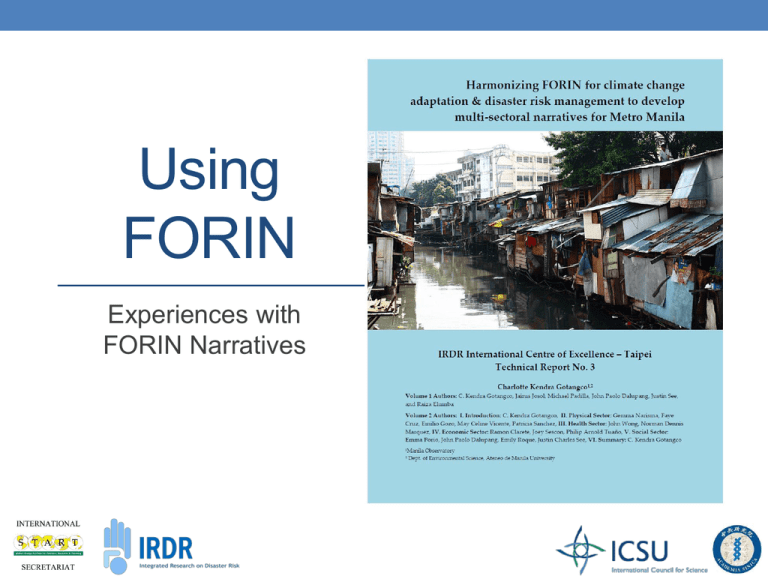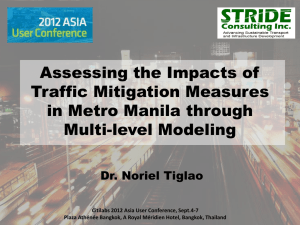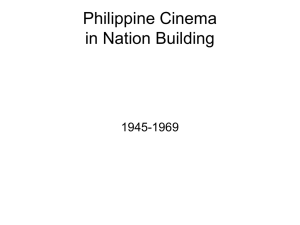Challenge in using FORIN
advertisement

Using FORIN Experiences with FORIN Narratives Research Objectives • Objective #1: To enhance the FORIN approach for application to the category of gradual hazards represented by changing climate “normals” in a manner that is consistent with the current application of FORIN to discrete extreme events. • Objective #2: To operationalize the framework in a preliminary multi-sectoral scoping process to develop FORIN narratives for Metro Manila, a coastal city at risk to climate change and extreme weather events. • Objective #3: To connect the critical factors and feedbacks contributing to climate change and disaster risk and resilience across all the sectors in a preliminary systems model of Metro Manila. Research Outputs • In response to Objective #1: Framework/guidelines for harmonizing the FORIN approach for CCA as well as DRM. • In response to Objective #2: Sectoral and integrated preliminary CCA-DRM FORIN narratives for Metro Manila. • In response to Objective #3: Preliminary multi-sectoral causal diagram as the structure for a systems model of Metro Manila. Challenge in using FORIN: Focus on discrete hazard events; Focus on DRM rather than CCA Context: Emphasis on Climate change Adaptation (CCA) – Disaster Risk Management (DRM) Mainstreaming “We want to produce CCA-DRRM compliant LGUs with enhanced CCA-DRRM mainstreaming capacity” - Local Government Academy Executive Director Marivel Sacendoncillo DRM and CCA: Points of Convergence and Difference Climate Change Adaptation: Disaster Risk Management Reduce risk to: Gradual changes in climatic parameters Sea level rise Changes in mean temperature Reduce risk to: Extreme weather events with increased frequency and severity Changes in precipitation patterns Climate- and weather-related events Direct connection Geophysical events Ecological events Other events (e.g. technological, terrorism) Hazards that are associated with extreme events Hazards that are associated with changing climate “normals” Gotangco 2012, adapted from Gotangco Castillo 2007; thanks also to IRDR FORIN Faculty Dr. Alan Lavell Rationale for CCA-DRM FORIN: • Need for a clear and holistic framework and approach to CCA in the same way as we have the FORIN approach for DRM. • Allow for analysis of common variables that affect risk and resilience to both climate change and disaster impacts. • Identify factors related to disaster risk (climate change) that can influence vulnerabilities to long-term climate changes (rapid onset extreme weather events). • Facilitate the CCA-DRM research and planning process to apply one integrative framework to the investigation and targeting of risk drivers. What we did to integrate CCA-DRM into FORIN… • Adapted hypotheses, objectives and templates • New guide questions (generic and sectoral) • Revised conceptual framework • Highlighted transformational aspect, recognizing indicators of both process and outcomes that can be traced • Suggested list of indicators by sector (risk indicators, M&E indicators) Research/Knowledge Risk Assessment o H, E, V o Past, Present, & Projected Including indigenous/traditional knowledge Capacity Building Communication Understanding & Awareness Governance (top-down laws & policies) Community-based strategies (bottom-up actions) Inter-sectoral, Multi-Stakeholder, & Transdisciplinary Approach Outcomes Risk Reduction Enhancing Resilience Building Adaptive Capacity Transformational Change Sustainable Development • The starting point for incorporating CCA with DRM in the FORIN approach was the recognition that risk can stem from discrete events as well as from gradual or continuous changes. • Conceptually straightforward but operationally challenging: problem of detection and attribution. • The “fingerprint” of historical gradual changes in climatic normals and their associated evolution of risks is difficult to detect in the midst of intervening factors and data issues. Challenge in using FORIN: Operationalizing Trans- and Inter-disciplinarity Sectors • Physical • Dr. Gemma Narisma (MO/ADMU-Physics), Dr. Celine Vicente (MO) • Social • Dr. Emma Porio, Emily Roque, John Paul Dalupang and Justin See (ADMU-Socio-Anthro) • Economic • Dr. Ramon Clarete (UP Economics), Randy Tuano (ADMUEconomics), Joey Sescon (ADMU-Economics) • Health • Dr. John Wong (ADMU-Health), Dr. Sio Marquez (ADMU-Health) General Narrative Outline I. Approach • Framework and Approach to CCA-DRM FORIN in Sector • Interfaces with Other Sectors II. Application to Metro Manila • Contextualization • Evolution of Risk in Metro Manila III. Conclusions and Recommendations • How to encourage inter-/trans- and not just multi- disciplinarity? • Need for levelling-off of sectoral approaches and perspectives and reconcile differences in paradigms and terminologies among the different sectors. • Having different perspectives can itself be a strength in building a more holistic picture of the issues at hand. However, more time and deeper involvement among participants are required to evolve a methodology that is truly integrative and collaborative. Challenge in using FORIN: Defining the scope of a “narrative” (vs. Longitudinal Analysis) Strengths/Benefits of FORIN: “Long view” “Out of the Box [Sector]” Thinking Analysis of connections and feedbacks treatment capacity and coverage + population/industries + volume of wastewater generated volume of WW treated - + volume of untreated WW + pollution load in water bodies surface water quality + + transport of sediments,solid waste, and other pollutants FLOOD HAZARD = f(Volume of water, Surface water quality) + tropical cyclone dilution + rainfall + MOVEMENT OF WATER input from other water bodies evaporation rate + overland flow + evaporation water entering the drains + + + water stored in soil surface run-off (PLUVIAL FLOOD) + + + + flow of seawater to river and land + + + ++ sea hydraulic head + water overflowing from rivers (FLUVIAL FLOOD) + - total available unbuilt land transported sediments & solid waste river channel capacity - seaward flow of water + + sediments & solid waste deposited + decay decay rate + - + dredging growth + + + physical structures along rivers - + land subsidence sediment velocity water in aquifer + absorbed solar radiation + groundwater extraction groundwater recharge air temperature local temperature + + + UHI effect global mean temp + storm surge wind + landward flow of seawater aquifer hydraulic head + fraction of built-up area + built-up area + tide levels (+/-) + + - construction growth rate + global sea level rise + height of water in rivers soil porosity via leakage to unconfined aquifers <tropical cyclone> - + + flow of water to sea water volume in rivers + + river-land hydraulic head pumping <rainfall> salt content of groundwater groundwater quality Josol & Gotangco. The feasibility of developing a physical hazard index model for climate change adaptation and disaster risk management (CCA-DRM) using a system dynamics approach: Case of Metro Manila, Philippines. Submitted to Natural Hazards. commercial and industrial wastewater SANITATION AND SEWERAGE (capacity to manage human waste) WATER ACCESSIBILITY (water consumed with respect to demand) domestic wastewater (effluent) domestic wastewater (influent) POLLUTION LOAD/ WATER QUALITY (capacity to manage wastewater in relation to the quality of the receiving water body) PHYSICAL SERVICES INDEX water supply organic load from uncollected waste rainfall FLOOD HAZARD INDEX floodwater quality and access to potable water production capacity WATER AVAILABILITY (efficient use of surface water supply and sustainability of groundwater) water demand extractable groundwater, available surface water WATER BALANCE (long-term availability of groundwater as a function of land-use and rainfall) MUNICIPAL SOLID WASTE (capacity to manange solid waste) flood volume (excess run-off and conveyance capacity) waste generation available surfaces for infiltration URBAN GROWTH (population and changes in surface characteristics) fdasf groundwater recharge volume, availability of surface water including those that are in reservoirs FORIN in Other Projects… **What is IRIACC-CCaR? • IRIACC-CCaR is a 5-year program involving in-depth studies of coastal megacities in Canada, Thailand, Nigeria and the Philippines. • CCaR aims to: • Develop and advance the knowledge base of CCA-DRRM of coastal megacities. This knowledge base will help us adapt to and cope with the effects of climate change. • Develop strategies and methodologies for CCA-DRRM • Enhance practitioner and academic capacity and transfer knowledge **IRIACC-CCaR: Development of a “City System Dynamics Risk Simulator” as a decision-making tool • Determination of sources of vulnerability and resilience • Social • Economic • Health • Physical • Organizational • Evaluation of adaptation options • Land use, urbanization scenarios • Risk communication policies ** Environmental History • ARC Linkage Grant under James Warren of Murdoch University, with Dr. Gealogo of Ateneo - History • Long history of Indo-Pacific region • Focus on interactions of human environment with socioeconomic, political, cultural developments • How these affect experience of disasters… **Environmental Communication • With Dr. Ponce de Leon of Ateneo Dept. of Communication, funded by Commission of Higher Education • Analysis of reception and perception of scientific information during extreme rainfall events • How do contexts influence non/use of scientific information? ACKNOWLEDGEMENTS: This project of the MANILA OBSERVATORY was supported by a grant to conduct follow-on research from the 2012 Advanced Institute on Forensic Investigations of Disasters (FORIN). Funding for participant follow-on research and this project was provided by ICSU and the US National Science Foundation Grant Number 0627839. The International START Secretariat is the implementing agency. The 2012 Advanced Institute on FORIN was organized by START and the IRDR International Centre of Excellence (ICoE) in Taipei, together with IRDR International, ICSU and Taiwan's National Science and Technology Center for Disaster Reduction (NCDR). Funding for the Institute was provided from ICSU.








